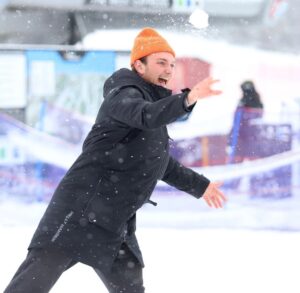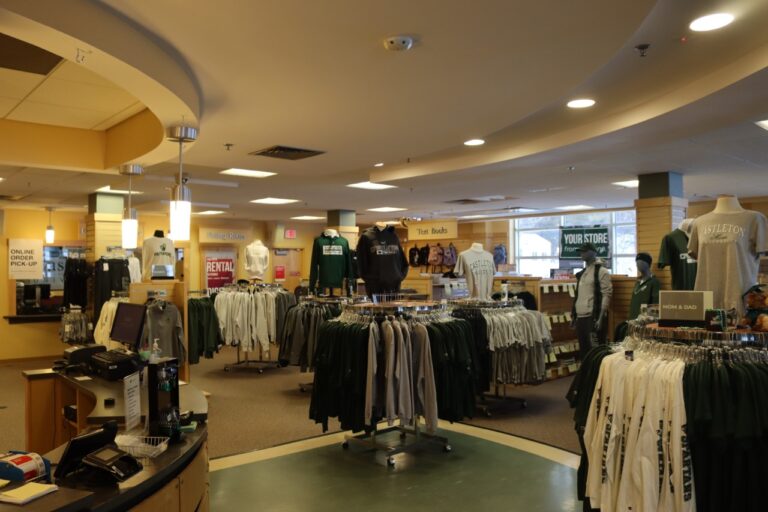‘Hero snow’ is a no-show

A competitive snowball fight among the Castleton Alpine Ski Team and skiers within the McConnell Division replaced the scheduled giant slalom race recently at West Mountain.
The nostalgic game was the most recent iteration in the chronicles of climate change; identifying how the lack of snow and warm weather has impacted the institution of skiing.
While many winter sports are directly exposed to the onslaught of climate change, alpine skiing is particularly vulnerable. It relies on specific snow conditions, namely icy, compact, and cold [often dubbed ‘“hero snow”], to train and compete properly. Forfeiting these conditions means forfeiting the sport that is central to many cultures and tied into the economies of multiple countries.
Captain of the Castleton Men’s Alpine Ski Team, Christopher Kerven, clarified why the race was postponed.
“After inspecting and slipping the course a couple of times on Friday, we could not follow through with the race because of the dangerous conditions,” he said.
These dangerous conditions refer to the wet and heavy snow which form banks along the course, leading to a higher rate of injury.
Though climate change is invariably an environmentally-focused issue, it reaches into the core of key economies and industries. According to a study conducted by Robert Steiger, 15% of the economic revenue in the Tyrol region of Austria is contingent on skiing, and as the weather continues to act sporadically, the industry and economy will suffer.
Petra Veljkovic, a junior and member of the Castleton Women’s Alpine Ski Team, compared the unfavourable weather in North America to her home in Europe.
“In Serbia it has been summer there now, it’s been 10 to 20 degrees [Celsius] everyday, so it has been bad,” Veljkovic said. “No snow, very bad conditions. Even glaciers in Austria, Italy, countries like that, they don’t have snow.”
Kerven also talked about the global ramifications of warmer temperatures.
“Hintertux [a popular glacier in Austria] has gotten worse and worse during pre-season, especially for professional athletes who go there to get an early start,” he said. “[Hintertux] used to be a good place to go, but the last couple years has been way less snow, grey snow, almost rivers running down the mountain that you have to ski over.”
When considering the relative impact of shifting snow conditions on ski races, freshman and Alpine Ski Team member, Aksel Strøm-Hansen, revealed how snow conditions can exaggerate the already unfair advantage held by skiers at the start of a race.
“It’s harder for the people in the back to have an equal chance to get a fast time. The bad snow has exacerbated the inequality between first and last bib,” Strom-Hanson said.
Strøm-Hansen arrived at Castleton from Norway, a country that excels in alpine ski racing. He recalled the dismal statistics that are beginning to emerge, portraying the ski industry as victim to climate change.
“Research from Norway shows that snow days, because of the recent warmer temperatures the past years, have had 20 days less,” he said.
According to Inside Climate News, the winter sports industry contributes $12.2 Billion to the U.S. economy, though the number of ski resorts in the U.S. has declined by 20% since 1992 – from 546 to 470. In an effort to replace the lost snow, resorts turn to snowmaking. However, at a cost of $500,000 annually, snowmaking is the economic landmine for many smaller resorts.
While snowmaking provides for an expensive solution, it also creates a paradox. Consider replacing snow lost to warmer temperatures with manmade snow that requires extensive water and electricity; it is clear that the solution may be unsustainable.
“I think skiing is a dying sport. In the future, the seasons will be shorter and shorter and we can adapt by creating better snow producing equipment, but eventually, it becomes so artificial you train and there’s no snow but the snow in the trails. And from a global warming perspective, it can’t be good to spend energy to produce snow and give life to a dying sport,” Strøm-Hansen commented.
Head coach of the Castleton Alpine Ski Team, Christopher Eder, provides an insight into the future of ski racing, suggesting that “perhaps the future is indoor ski facilities, like the one that opened a few years ago in New Jersey. A place where one can control the climate indoors and one can ski in January and or July.”
Eder’s prediction highlights the growing disconnect between skiing and the natural environment. Indeed, the sport being taken out of its original environment is disappointing, but it poses broader questions related to the survival of human activities in conjunction with a changing climate.
“All resources are forced to produce man-made snow. For ski racers it is good, but it is sad that we are required to interfere with nature to keep doing what we love,” Strøm-Hansen said.
Recent snowfall has placed optimistic lenses upon the eyes of skiers and winter-lovers, though the predicted inches superficially veil the chronic disease of climate change that threatens the viability of the ski industry.
“The future of skiing is in a very dark spot right now,” Kervin said.







